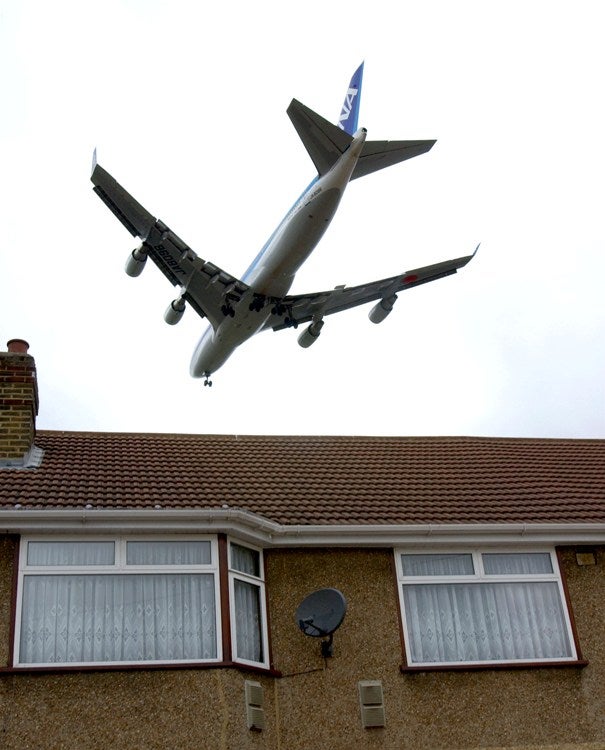The Heathrow clearances: village to be bulldozed for new runway

Sipson's bucolic charm has faded a little since its oldest resident Jack Clark, 96, drove a steam engine to Covent Garden each morning laden with fruit and vegetables that thrived in the rich soils of the surrounding Middlesex fields.
Today the heady scents of the market gardens have given way to the smell of jet fuel; the blacksmith's hammer silenced by the march of time and the roar every 90 seconds of the jet engines from Sipson's mighty neighbour, Heathrow airport.
Yet this small population, hemmed in by a matrix of runways and motorways, considers itself to be still very much a village in the old style. There are three pubs, a shop and a popular local school but above all a thriving community spirit. It is a spirit which, should Heathrow's owners BAA get their way this year, will be buried irrevocably under hundreds of thousands of tons of concrete.
On Monday, residents, whose 700 homes will be bulldozed to make way for a third runway and a sixth terminal building at Heathrow should it get the go ahead, will head 14 miles down the M4 into central London where they will link up with thousands of other people who fear their lives are about to be desperately blighted by the plans.
The rally in Westminster, timed to coincide with the end of a consultation period next Wednesday, will be addressed by opponents of expansion. These include opposition parties, neighbouring councils, local MPs and candidates in the election for Mayor of London as well as environmentalists and thousands of homeowners.
It is estimated that some two million people across a vast swath of the South-east will be affected should the Government decide, as expected, that new infrastructure is needed for the airport to keep pace with international rivals.
But campaigners say noise pollution will become unbearable from Greenwich to Windsor with 50 per cent more planes using Heathrow by 2030 – 700,000 each year or the equivalent of a Gatwick airport added to the already vast west London complex.
It is a far cry from the days when Mr Clark worked for the local farmer Wild and Robbins. In the 1920s the village was famous for its vineries. There was a village green and thatched cottages. On Sundays local children would swim in the tributaries of the river Colne, now little more than a trickle.
"It was a real village in them days – it was something else, a nice quiet place," recalled Mr Clark from the front room of the tiny cottage where he and his late wife raised four sons. "The only vehicle we would ever see would be the odd motorbike going through. They say if Churchill had ever known what was going on he would never have allowed them to build the airport here in the first place."
Saleh Ahmed, the manager of the local Indian restaurant Achari, is concerned about the future. The airport and nearby business centres provide a steady stream of customers. "It is going to happen," he said. "I have been to some of the meetings and they say they will compensate us but it is not in our hands. The decision has already been rubber-stamped."
Peter and Gaynor Rumble, both aged 76, have been living in their cottage for more than 40 years. "When we moved here the fourth terminal was being built," said Mr Rumble. "They said that if they got that there will be more need for expansion. They've just got the fifth terminal, now they want a sixth and a new runway. Where does that leave us? We are in limbo."
Locals say they are being bullied into accepting BAA's offer of a transferable bond which values their home in relation to 2002 prices. If they don't sign up and their homes are compulsorily purchased, they will receive only the basic level of compensation. But three-bedroom homes in Sipson sell for £100,000 less than similar properties in nearby areas less blighted by the planes.
BAA insists that its offer is generous and the airport is vital to the area's economy. A spokesman said: "Heathrow is full and vulnerable to foreign competition. The Government has been very clear that the development can go ahead within the limits of noise, air-quality and public-transport requirements. This is growth within environmental limits."
But back in Sipson, Debbie Power, landlady of the 16th-century King William IV pub, was less convinced. "Money can buy you a new house or a new business but it can't buy you a new community or new friends," she said. "This is a good village."
Subscribe to Independent Premium to bookmark this article
Want to bookmark your favourite articles and stories to read or reference later? Start your Independent Premium subscription today.

Join our commenting forum
Join thought-provoking conversations, follow other Independent readers and see their replies